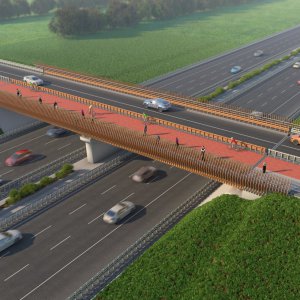Internship Pieter van Loon
Initially, the plan was to go abroad for a semester, study in Norway, enjoy some mountains, and learn a bit about timber structures. Of course, this was no longer an option with the current pandemic. Instead, I decided to do an internship and learn about the practical implications of timber structures. This led me to Lüning, a structural engineering firm in Velp, with timber structures as their core business.
The internship is made up of two parts; part one consists of the practical everyday work of a (junior) engineer, part two consists of a small research on the circularity of timber. For the first part, I tag along with the projects of the structural engineers. At the time of writing, it mainly consisted of projects in their first stage, when little more than a sketch design has been made.
Because of their specialization in timber, Lüning is often approached with the question 'can this be executed in timber?' by architects and project developers. Gert-Jan (the director of the company) gave me a very practical slogan for these questions: "Anything can be constructed in timber until it is invalidated:' With so many engineering firms relying heavily on concrete and steel, it is nice to see this timber first approach. Of course, they are not blind to the limitations of timber. Whenever timber is proven to be too impractical or costly, they will happily find the most efficient steel or concrete alternative.
One of the noteworthy projects I was involved with was a tender bid by an architect, who wanted to know if his gym design with a roof span of 28.5 meters would be possible in timber. After some quick sketches by a senior engineer, it was up to me to prove that the span was indeed possible, while also staying within the tight restrictions concerning building height. Luckily, this proved to be no problem with even a rather standard glulam beam.
The second part of the internship, the research about the circularity of timber, is in response to a study done by ABT on the topic of what would be the most sustainable floor system [1]. One of the results showed that concrete hollow-core floors are more favorable than CLT floors when assessing their environmental impact with the 'Nationale Mileudatabase'. This is against the gut-feeling of the engineers at Lüning. After a very interesting meeting with, among others, the head of NIBE - an institute that assesses the environmental impact of products used in the construction industry - it was clear that the end of life scenarios for timber elements is underdeveloped.
To provide a bit of context, the environmental impact is determined via Life Cycle Assessments (LCA), where every stage of a product's life is evaluated on embedded carbon, transport emissions, required energy, and so on. At the end of this evaluation, a single monetary value is given to this element, representing the costs needed to offset the environmental impact. The end-of-life scenario can significantly reduce these costs by proving the product can be reused or recycled, thus saving emissions with the cradle-to-cradle principle. For timber products, this scenario is underdeveloped, resulting in a low reduction of the environmental impact. My research aims to prove, with some case studies, that timber can indeed be reused, resulting in a more favorable end-of-life scenario.
While the research into circularity was unexpected, it is an interesting addition to my internship. I have learned a lot so far and I am curious what my internship will furthermore bring.
References:
[1] Lonneke van Haalen (November 2018), Duurzaamheid begint met de juiste vloerkeuzve, Bouwwereld, issue 10 (2018)





